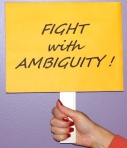
When a person “fights with” ambiguity, does that means that they are on the same side, the opposing side, or that ambiguity is a tool for fighting?
But of course… all of these meanings are possible…
Both or Neither
am·bi·gu·i·ty noun \ˌam-bə-ˈgyü-ə-tē\
A simple definition of ambiguity is that it signifies words, concepts, and situations that have multiple meanings. The Latin prefix ambi- means both.
For example, an ambidextrous (“both right”) person writes well with both hands, and an ambivalent attitude (“values both”) is one that is indifferent towards a the merits of a choice.
When organizations formulate strategy, they find themselves facing many vague, conflicting signals. Strategists spend much time and effort using tools of context analysis to interpret the threats and opportunities.
With Complexity Comes Ambiguity
In career development, people start with simpler tasks and master them with process and methodology.
As people develop in their career they:
Must expect to encounter ambiguity as they transition to more complex situations in their organizations. Strategic leaders must do a great deal of consensus building… to uncover information not previously held, perspectives not previously understood, and knowledge not previously applied to the solution-generating task. The challenge to strategic leadership is recognizing that the decision maker cannot have a “stand-alone” perspective.
~Strategic Leadership and Decision Making
US Air Force’s National Defense University
 To paraphrase, your job as leader is to accept that the strategic environment is interpreted by people and their subjective biases; it can never be fully understood.
To paraphrase, your job as leader is to accept that the strategic environment is interpreted by people and their subjective biases; it can never be fully understood.
Your job is to cut ambiguity by uncovering information, perspectives, and knowledge.
Academics tell us that organizations do poorly at implementing strategy. Few of these scholars recognize the role of individual perspective: each individual has their own worldview that influences how they make sense of ambiguity. Thus,
Strategy – the process of getting important things done – is largely a language game, where leaders use conversation to understand different individual perceptions of a problem or opportunity and gain commitment toward making progress.
We’re Number ONE!?
Ambiguous Goals
Sometimes leaders are sloppy with their language, but sometimes their ambiguity is intentional.
What would you think if the CEO of your organization announced This statement:
“Our vision is to be Number 1!”
One could interpret this statement in several ways. For example, one could think that:
- Being #1 could mean “to posses the largest market share.” If that is the case, you need to work through the definition of core market and adjacent markets. If you sell into numerous markets, this becomes a very fuzzy mandate.
- Being #1 could be a ranking on a list. The phone maker Nokia is ranked as the #1 most-trusted brand in many countries, but that trust has not created business advantage (in February 2011, its business difficulties drove it into the arms of Microsoft).
- Being #1 could mean short term profitability in an industry group. This could be achieved by massive cost-cutting of R&D, but might destroy the ability to innovate with new products. That might not be good for long-term performance.
- Being #1 could be trying to inspire people. Perhaps the CEO did not intend to make this a strategic initiative that would strategy that will require resources.
Let’s assume this goal to “be #1” really is a strategic initiative and you are assigned to lead the project. Your top priorities should be to recognize ambiguity, clarify the metrics and develop sensible action plans.
Balancing the Polarities
Many people like things “black and white, with no shades of gray.” These are the people who will often struggle the most when in an ambiguous situation. So, your job is balancing two polarities: The first is an attitude that is tolerant, accepting, and patient. Leaders realize that they can’t let a rush to closure force them into a bad decision.
“The creative person is willing to live with ambiguity. He doesn’t need problems solved immediately and can afford to wait for the right ideas. ~ Abe Tannenbaum
 The second polarity is active resolution of tensions. It is important for the leader to step up with some structure and direction.
The second polarity is active resolution of tensions. It is important for the leader to step up with some structure and direction.
The leader starts the process of asking questions and encourages other to probe into the unknown and the assumptions.
The goal: a flexible plan that sets a direction but is open to new learnings.
But how is this balance practiced?
It might take some confident statements such as,
- “The company has selected you to join this team because you are smart and have performed well in the past. If we trust each other, we will get this figured out.”
- “Although we just starting our planning, I’m confident that when we’re done we will have a detailed roadmap for implementing this initiative. We have a lot of questions, and we will learn the answers to those questions.”
- “A lot of smart people have worked hard on strategy formulation. Let’s resolve ourselves to doing a good job, and that includes managing the threats and the opportunities.”
Someone once quipped, “Give me ambiguity or give me something else.” How do you fight with ambiguity?
—————-
Greg Githens helps organizations turn vision into results
He does this through coaching, seminars, speaking, and consulting
Email | LinkedIn | Facebook | Blog | Web
Image Sources: adeepwell.com


[…] This post was mentioned on Twitter by Tom Schulte, Amanda Russell. Amanda Russell said: Clearing The Leader Fog: Fighting Ambiguity! http://bit.ly/htUZXn […]
[…] Ambiguity Can Be Your Ticket To […]